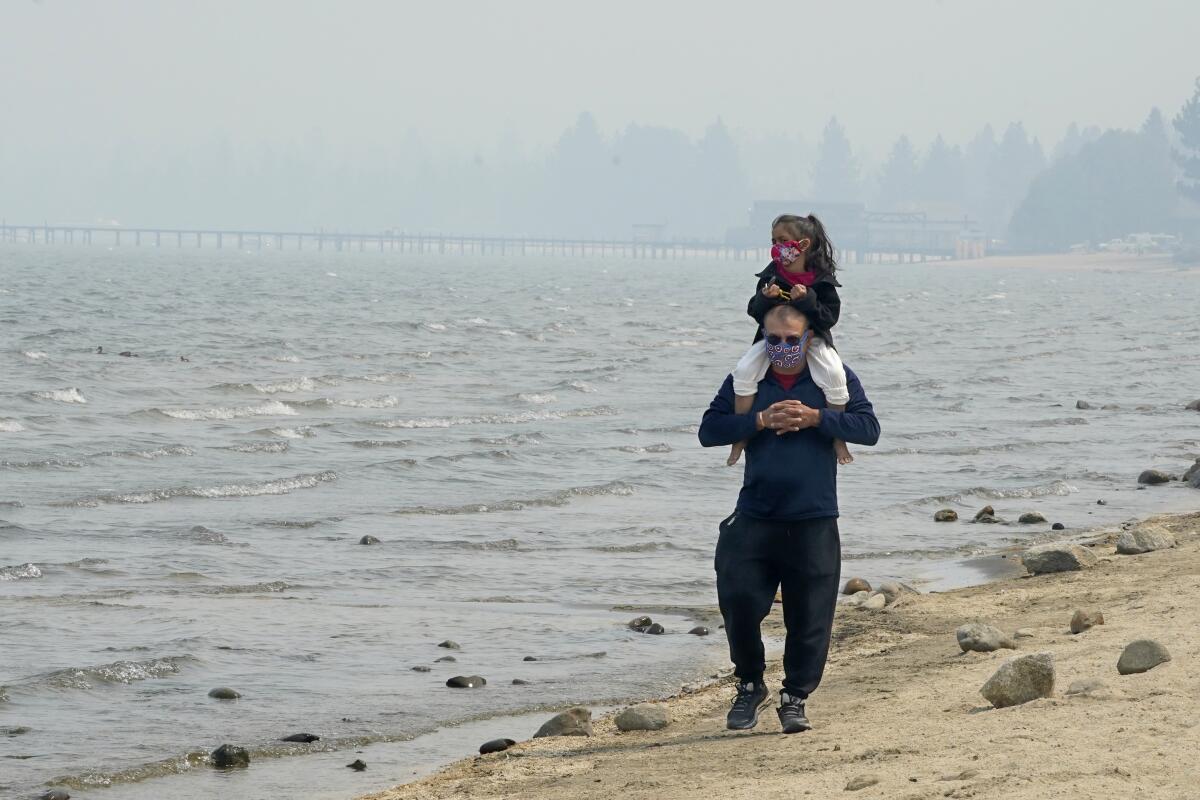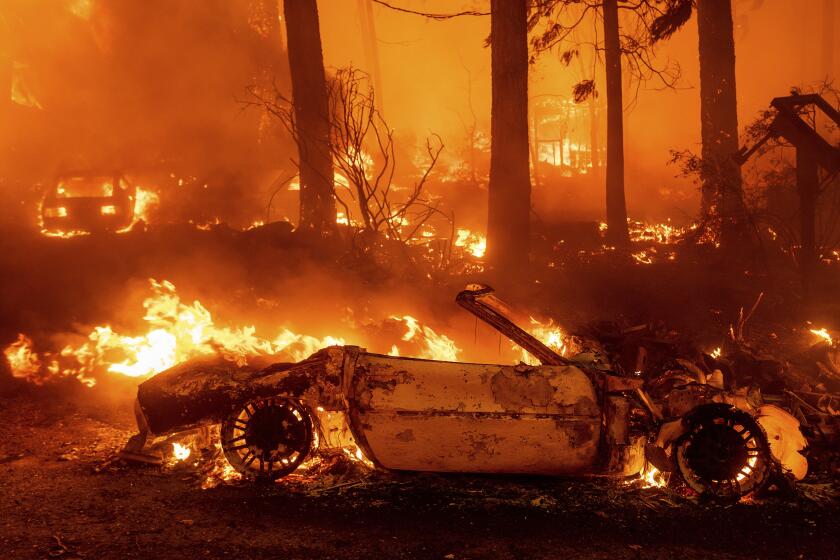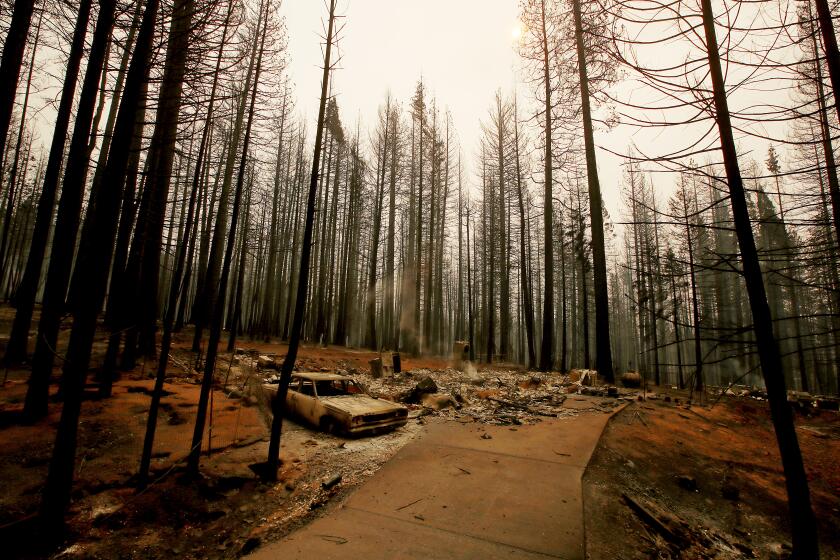Caldor fire pushes toward Lake Tahoe, causes record-breaking air pollution

- Share via
Several spot fires erupted on the eastern edge of the Caldor fire as the growing blaze pushed closer to South Lake Tahoe, belching smoke that has caused record-breaking air pollution and spurring anxiety the fire could reach resort communities.
One spot fire that ignited Monday had jumped to around 100 acres by the late afternoon and was “growing at a fairly rapid pace,” said Eric Schwab, an operations section chief with the California Department of Forestry and Fire Protection. On Tuesday, the most distant of the small blazes appeared to be about a mile ahead of the eastern edge of the fire and less than a mile south of Highway 50, where personnel were concentrating on protecting structures, fire officials said.
None of the spot fires jumped over firefighters’ containment lines, and authorities have not issued evacuation warnings or orders for the Lake Tahoe area. But nearly 30,000 people have already fled the fire as it has chewed its way through El Dorado County, and U.S. Forest Service officials recently ordered the closure of several backcountry areas near the lake, including Desolation Wilderness, Meiss Country, Barker Pass and McKinney/Rubicon.
Even in the absence of formal orders, some on social media announced they were leaving or avoiding the Tahoe Basin because of another scourge: horrendous air quality that has turned skies an eerie orange and sent ash raining from the sky.
Just over the state line, in Reno and Sparks, Nev., Washoe County recorded its all-time worst concentration of small particulate matter — known as PM2.5 — Monday, according to the county Washoe County Health District Air Quality Management Division. The agency said the area averaged an air quality index of 251, which is considered very unhealthy, and declared a Stage 3 emergency.
An air quality rating of 300 and above is considered hazardous — a level that many of the typically picturesque areas around Lake Tahoe far exceeded Monday.
On Tuesday afternoon, Tahoe Vista, a census-designated place along the north shore of the lake, had a rating of 448 — the worst in the U.S. and a staggering 42 times above the World Health Organization’s exposure recommendation.
A dozen large wildfires that are raging in Central and Northern California are spewing hazardous smoke and ash into the atmosphere. To the east of the Caldor fire, the lightning-sparked Tamarack fire has burned 68,637 acres since igniting July 4 and was 82% contained, according to the most recent incident report.
Smoke from the fires even triggered an advisory in parts of Los Angeles, Riverside and San Bernardino counties — hundreds of miles to the south — through Tuesday. The South Coast Air Quality Management District, which issued the advisory, said the Coachella Valley was likely to experience air deemed unhealthy for sensitive groups, and parts of L.A. and the Inland Empire could see similar conditions.
On Tuesday, firefighters were continuing to focus on trapping the blaze west of Highway 89, an artery that borders the western edge of Lake Tahoe. “This has become a huge priority, to stop the eastern spread of the fire,” Schwab said at a community meeting on Monday.
Personnel are also battling flames along the southwestern edge of the fire, not far from where it began Aug. 14 and tore through the community of Grizzly Flats.
Since igniting more than a week ago, the fire has swelled to 117,704 acres, with explosive growth over the weekend. It has burned at least 455 homes, 11 commercial buildings and 166 minor structures. At least 17,000 structures are still threatened by the conflagration, which is 9% contained.
California fire seasons are growing longer and more destructive. This year’s still-raging Dixie fire quickly flared into one of the largest yet.
Among many rapidly growing fires in the state, the blaze has now become the “No. 1 priority,” said Capt. Jason Hunter, a spokesperson for the fire. Resources flowing in from other areas are easing an initial shortage with more than 2,100 personnel dedicated to the blaze on Tuesday, up from 1,700 the day before. “We’re expecting another surge tomorrow,” Hunter said.
Fire growth has slowed in recent days, but weather officials say an incoming trough is bringing wind and atmospheric instability. Gusts around the burn area were expected to pick up Tuesday, which could clear out the smoke in some places but could also spread the fire, officials said.
A low-pressure trough sitting off the coast is forecast to move over the region Tuesday evening and into Wednesday, driving down temperatures but elevating wind speeds to an average of 20 to 25 mph, with gusts up to 30 mph, according to the National Weather Service. Winds will be coming from the southwest, likely pushing the flames northeast — toward Lake Tahoe.
More than 17,000 structures remain under threat from the blaze, which is 5% contained.
Marvin Boyd, a meteorologist with the weather service’s Reno station, said that vegetation is so parched in the area that winds, while not considered “critical,” could easily spur fire activity. Much of the state is in an exceptional drought, which has primed vegetation — fuel for fires — to burn.
Boyd called the situation “very volatile.”
Given the conditions, “it doesn’t take a lot for a tree to catch fire,” he said. “And then it will burn hotter, basically, and faster.”
Temperatures are expected to rise later in the week in Northern California, another factor that can increase fire behavior, meteorologists warn. Through Wednesday, the mercury is expected to hover in the low to mid-70s before jumping to the low to mid-80s beginning Thursday.
“The honest situation is there’s no help from the weather anytime soon,” Boyd said.
More to Read
Sign up for Essential California
The most important California stories and recommendations in your inbox every morning.
You may occasionally receive promotional content from the Los Angeles Times.











